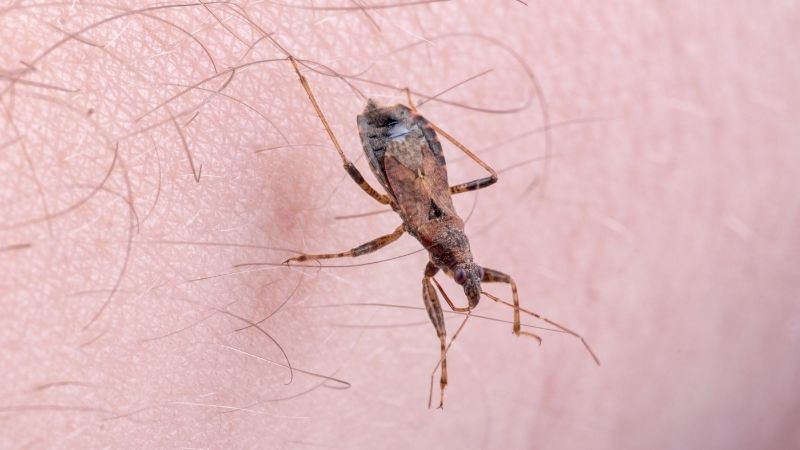
Where do kissing bugs hide in a home?
I: Introduction:
Kissing bugs are blood-sucking insects that belong to the assassin bug family. The name kissing bugs comes from the way they bite human beings on the face, generally while they are sleeping. They have a wide range of hosts. These bugs can be found in places like Central and South America, where there is a high prevalence of Chagas disease.
They belong to the family Reduviidae, and are also known as assassin bugs for their predatory behavior. The kissing bug bites and attaches itself to people and animals to feed on their blood. It can carry a parasite called Trypanosoma Cruzi that is responsible for Chagas disease. Kissing bugs are the leading cause of Chagas disease in the United States.
Chagas disease causes an allergic reaction. It can affect the heart, digestive track, brain, and other organs, and can be fatal. Therefore, you need to know where kissing bugs hide in your home.
II: Where Do Kissing Bugs Hide in your home:
The easiest and probably the most common place for kissing bugs is a bedroom. They prefer dark places and will wait there to greet you at eleven o’clock in the evening.
The most common way for kissing bugs to enter your home is through small cracks and crevices around windows or doors. It's important to inspect your house for these areas of entry and eliminate them.
According to the University of California, Santa Cruz, kissing bugs live and feed in warm, moist environments. They like to live in wall voids, under sinks, behind baseboards, and in other dark, hidden places.
Kissing bugs are attracted to humans and the smells associated with them. The best place for them is where there is food available. This creature has a really strong sense of hearing and smells. If you have a small dog there is a good chance that he will sense the presence of the kissing bugs and alert you.
III: How to prevent kissing bugs in your home:
It's important to know what to do if you find a kissing bug in your home. You can call an exterminator to come out and remove it for you.
There are several preventative measures can be taken to prevent kissing bugs from entering your home. Start by inspecting the foundation of your home for cracks and crevices that could allow kissing bugs to enter.
- Use caulk to seal any gaps around windows and doors.
- Make sure the areas under doors are free of clutter.
- Check for unsecured louvers around chimneys and vents.
- Remove dense vegetation that hugs your home. This will also help reduce the risk of infestation.
Things you can do to prevent kissing bugs from entering your home. First, seal up any cracks or openings in the walls of your home. Second, make sure that any firewood that you bring into your home is completely dry. And third, keep your doors and windows shut at all times.
IV: How to get rid of kissing bugs:
Kissing bugs are not as harmless or funny-sounding as their name may imply. In fact, these blood-sucking insects are responsible for infecting nearly 20,000 people with a disease called Chagas every year. Although we cannot completely eradicate kissing bugs from our world (or even our backyards) we can help protect ourselves by following certain steps.
1. Use a Bug Zapper
Using a bug zapper inside your home is a great way to get rid of pesky, nocturnal pests that might otherwise fly around in the dark of night. Since these pests disappear during the day, it would be hard to locate them, but with a bug zapper, they will be drawn to the tempting light of the bug zapper, which will kill them on contact. Set up your bug zapper near where kissing bugs might be.
2. Add Essential Oils
Some people swear by using essential oils to keep kissing bugs out of the house. In addition to using these oils, you can keep kissing bugs out of your home by using other methods. For example, you can sprinkle lemon or eucalyptus oil near potential entryways, or you can burn them in a diffuser.
3. Swap your lightbulbs
Outdoors, your porch lights may attract dangerous bugs. Assassin bugs are drawn to these lights, which can be dangerous to your family and pets. However, a simple swap of your regular bulbs for bug-light bulbs can help reduce populations around the house. Alternatively, you should make sure to close exterior doors tightly at night.
4. Contact a Pest Control Company
Kissing bugs are hard to get rid of, so they're a huge pain to deal with. Kissing bugs are extremely dangerous because they can transmit diseases into your home. If you see a bug in your house, you should contact a pest control company to get rid of kissing bugs.
V: Conclusion:
Kissing bugs are called assassins for reason. These silent killers are known to cause nightmares and even death. They are very dangerous and should be treated with caution.
It's important to know what to do if you find a kissing bug in your home. You can call an exterminator to come out and remove it for you,